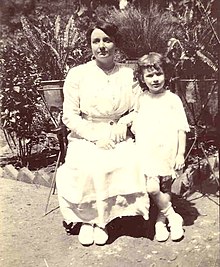 British Raj era Anglo-Indian mother and daughter, c. 1920 | |
| Total population | |
|---|---|
| c. 500,000 [1] | |
| Regions with significant populations | |
| 300,000-400,000( 1996 )[2] 125,000-150,000( 2010 ) [3][4][5] | |
| 86,000[6] | |
| 22,000 | |
| 22,000 | |
| 20,000[7] | |
| 20,000 | |
| 19,200[8] | |
| 15,861 | |
| 10,310 | |
| 4,800 | |
| <1,500[9] | |
| Languages | |
| English (British, Indian), Hindustani (Hindi, Urdu), Bengali, Punjabi, Tamil, Kannada, Marathi, Malayalam, Oriya, Telugu, and other Indian languages | |
| Religion | |
| |
| Related ethnic groups | |
| Anglo-Burmese, Scottish-Indians, Irish Indians, Burghers, Kristang people, Indo people, Singaporean Eurasians, Macanese people, Indo-Aryan people, Dravidian people, British people, Indian diaspora | |
Anglo-Indian people are a distinct minority community of mixed-race British and Indian ancestry. During the colonial period, their ancestry was defined as British paternal and Indian maternal heritage; post-independence, "Anglo-Indian" has also encompassed other European and Indian ancestries. Anglo-Indians' first language is usually English.[10][11][12] Prior to 1911, various designations like "Eurasian" or "Indo-Briton" were used to describe this community.
The All India Anglo-Indian Association, founded in 1926, has long represented the interests of this ethnic group; it holds that Anglo-Indians are unique in that they are Christians, speak English as their mother tongue, and have a historical link to both the British Isles and the Indian sub-continent.[13] Anglo-Indians tend to identify as people of India, mostly in Kolkatta and Chennai, (or Bangladesh, Sri Lanka or Pakistan), rather than of a specific region such as Bengal.[13] 2 August is celebrated as World Anglo Indian Day.
During the period of British rule in India, children born to unions between British fathers and Indian mothers from the 17th century onwards formed the basis of the Anglo-Indian community. This new ethnic group formed a small yet significant portion of the population and became well represented in certain administrative roles. As Anglo-Indians were mostly isolated from both British and Indian society, their documented numbers dwindled from roughly 300,000 at the time of independence in 1947 to about 125,000–150,000 in modern day India. During much of the time that Britain ruled India (the Raj), British-Indian relationships faced stigma, which meant that the ethnicity of some Anglo-Indians was undocumented or identified incorrectly. As such, many have adapted to local communities in India or emigrated to the United Kingdom, Australia, Canada, the United States, South Africa and New Zealand, where they form part of the Indian diaspora.[9][14]
Similar communities can also be seen in other parts of the world, although in smaller numbers, such as Anglo-Burmese in Myanmar and Burghers in Sri Lanka.[15]
- ^ Moore, Gloria J. “A Brief History of the Anglo-Indians.” International Journal of Anglo-Indian Studies, vol. 1, no. 1, 1996, international-journal-of-anglo-indian-studies.org/index.php/IJAIS/article/view/78.
- ^ "Anglo-Indian Schools and Anglo-Indian Educational Disadvantage, Part 2", International Journal of Anglo-Indian Studies, Vol. 1 No. 2 (1996)
- ^ Moore, Gloria J. “A Brief History of the Anglo-Indians.” International Journal of Anglo-Indian Studies, vol. 1, no. 1, 1996, international-journal-of-anglo-indian-studies.org/index.php/IJAIS/article/view/78.
- ^ https://minorityrights.org/communities/anglo-indians/
- ^ James, SP (2010). "The Origins of the Anglo-Indians". International Journal of Anglo-Indian Studies.
- ^ Blair Williams, Anglo Indians, CTR, 2002, p.189
- ^ Anton Williams, Jake Peterson, Alexsander Stevenova, Jennifer Michealson's New Survey (2016) of Bangladesh Population Research: "There are almost 20,000 Anglo-Indians living in Bangladesh." (The Natives of India) The Comparative Studies about Bangladesh. Retrieved 18 February 2016.
- ^ a b Fisher, Michael H. (2007), "Excluding and Including 'Natives of India': Early-Nineteenth-Century British-Indian Race Relations in Britain", Comparative Studies of South Asia, Africa and the Middle East 27 (2): 303–314 [305], doi:10.1215/1089201x-2007-007
- ^ Oxford English Dictionary, 2nd ed. (1989)
- ^ "Anglo-Indian", Dictionary.com.
- ^ "Anglo-Indian". Oxford Dictionary Online. Archived from the original on 14 November 2011. Retrieved 30 January 2012.
- ^ a b Andrews, Robyn (2013). Christmas in Calcutta: Anglo-Indian Stories and Essays. SAGE Publishing India. ISBN 978-81-321-1814-5.
- ^ "Some corner of a foreign field". The Economist. 21 October 2010. Archived from the original on 3 February 2023. Retrieved 7 March 2023.
- ^ Ferdinands, Rodney (1995). Proud & Prejudiced: the story of the Burghers of Sri Lanka (PDF). Melbourne: R. Ferdinands. pp. 2–32. ISBN 0-646-25592-4. Archived from the original (PDF) on 22 March 2015.